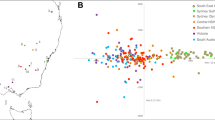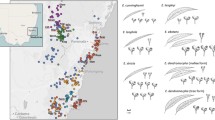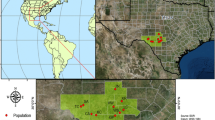Abstract
The rare Tasmanian endemic Eucalyptus risdonii is thought tohave arisen as a result of small, heterochronic changes to the genome ofits more widespread sister species, E. tenuiramis. Previousmorphological studies have shown that genetic differentiation betweenpopulations of E. risdonii and southern E. tenuiramisis continuous and much smaller than the separation between the southernand northern morphotypes of E. tenuiramis. However,morphological traits may be influenced by selection, possibly leading toconvergence, requiring an independent measure of genetic variation. Westudied allozyme frequency variation in E. risdonii, southernE. tenuiramis (parapatric with E. risdonii), northernE. tenuiramis (disjunct from southern populations), and E.coccifera (as an outgroup). Each morphotype had a level of geneticdiversity close to the average reported in ten other eucalypt specieswith similar distributions but the coefficients of populationdifferentiation within morphotypes were lower than in most othereucalypt species. The overall difference between morphotypes wasextremely small, possibly as a result of recent and rapiddifferentiation, but may also be the result of gene flow from otherpeppermint taxa, including E. amygdalina and E.pulchella. Southern E. tenuiramis has greater geneticaffinity with E. risdonii than with northern E.tenuiramis which supports recent evolutionary divergence of E.risdonii. In this study we have shown that taxonomic units are notnecessarily aligned with an equitable partition of the gene pool andthat conservation units should be much broader than single taxa in orderto preserve evolutionary processes.
Similar content being viewed by others
References
Avise JC (1994) Molecular Markers, Natural History and Evolution. Chapman & Hall, USA.
Chippendale GM (1988) Flora of Australia, Volume 19. Australian Government Publishing Service, Canberra.
Conkle MT, Hodgskiss PD, Nunnally LB, Hunter SC (1982) Starch Gal Electrophoresis of Conifer Seeds: A Laboratory Manual. General Technical report PSW64. Pacific Southwest Forest and Range Experimental Station, USA.
Curtis WM, Morris DI (1975) The Student's Flora of Tasmania, Part 1, 2nd edn. Tasmanian Government Printer, Hobart.
Hopper SD (1995) Evolutionary networks: Natural hybridisation and its conservation significance. In: Nature Conservation 4: The Role of Networks (eds. Saunders DA, Craig JL, Mattiske EM), pp. 51–66. Surrey Beatty and Sons, Sydney.
House APN, Bell JC (1996) Genetic diversity, mating system and systematic reltionships in two red mahoganies, Eucalyptus pellita and E. scias. Aust. J. Bot., 44, 157–174.
Jackson HD, Steane DA, Potts BM, Vaillancourt RE (1999) Chloroplast DNA evidence for reticulate evolution in Eucalyptus (Myrtaceae). Mol. Ecol., 8, 739–751.
Kennington WJ, James SH (1998) Allozyme and morphometric variation in two closely related mallee species from Western Australia, Eucalyptus argutifolia and E. obtusiflora (Myrtaceae). Aust. J. Bot., 46, 173–186.
Ladiges PY, Humphries CJ, Brooker MIH (1983) Cladistic relationships and biogeographic patterns in the peppermint group of Eucalyptus (informal subseries Amygdalininae, subgenus Monocalyptus) and the description of a new species, E. willisii. Aust. J. Bot., 31, 565–584.
McKinnon GE, Steane DA, Potts BM, Vaillancourt RE (1999) Incongruence between chloroplast and species phylogenies in Eucalyptus subgenus Monocalyptus (Myrtaceae). Am. J. Bot., 86, 1038–1046.
McKinnon GE, Vaillancourt RE, Jackson HD, Potts BM (2001) Chloroplast sharing in the Tasmanian eucalypts. Evolution (in press).
McNamara K (1989) The great evolutionary handicap. New Scientist, 16th Sept., 29–33.
Moran GF, Bell JC (1983) Eucalyptus. In: Isozymes in Plant Genetics and Breeding (eds. Tanksley SD, Orton TJ), pp. 423–441. Elsevier, Amsterdam.
Moran GF, Hopper SD (1987) Conservation of the genetic resources of rare and widespread eucalypts in remnant vegetation. In: Nature Conservation: The Role of Remnant and Native Vegetation (eds. Saunders DA, Arnold GW, Burbige AA, Hopkins AJM), pp. 151–162. Surrey Beatty and Sons, Sydney.
Moran GF, Bell JC, Prober S (1990) The utility of isozymes in systematics of some Australian tree groups. In: Plant Systematics in the Age of Molecular Biology (eds. Ladiges PL, Martinelli LW), pp. 47–57. CSIRO, Melbourne.
Nei M (1973) Analysis of gene diversity in subdivided populations. Proc. Natl. Acad. Sci. USA, 70, 3321–3323.
Potts BM (1986) The population dynamics and regeneration of a hybrid zone between Eucalyptus risdonii and E. amygdalina. Aust. J. Bot., 34, 305–329.
Potts BM, Jackson WD (1986) Evolutionary processes in the Tasmanian high altitude eucalypts. In: Flora and Fauna of the Alpine Australasia. Ages and Origins (ed. Barlow BA), pp. 511–527. CSIRO, Melbourne.
Potts BM, Reid JB (1988) Hybridisation as a dispersal mechanism. Evolution, 42, 1245–1255.
Potts BM, Wiltshire RJE (1997) Eucalypt genetics and genecology. In: Eucalypt Ecology: Individuals to Ecosystems (eds. Williams JE, Woinarski JCZ), pp. 56–91. Cambridge University Press, Cambridge.
Prober S, Bell JC, Moran GF (1990) A phylogenetic allozyme approach to understanding rarity in three ‘green ash’ eucalypts (Myrtaceae). Plt. Syst. Evol., 172, 99–118.
Prober SM, Brown AHD (1994) Conservation of the grassy white box woodlands-population genetics and fragmentation of Eucalyptus albens. Cons. Biol., 8, 1003–1013.
Sale MM, Potts BM, West AK, Reid JB (1996a) Relationships within Eucalyptus (Myrtaceae) using PCR-amplification and southern hybridisation of chloroplast DNA. Aust. Syst. Bot., 9, 273–282.
Sale MM, Potts BM, West AK, Reid JB (1996b) Molecular differentiation within and between Eucalyptus risdonii, E. amygdalina and their hybrids using RAPD markers. Aust. J. Bot., 44, 559–569.
SAS Institute (1997) SAS/STAT Software Enhancements Through Release 6.12. SAS Institute Inc., Cary, NC, USA.
Steane DA, McKinnon GE, Vaillancourt RE, Potts BM (1999) ITS sequence data resolve higher level relationships among eucalypts. Mol. Phylo. Evol., 12, 215–223.
Turner C, Wiltshire RJE, Potts BM, Vaillancourt RE (2001) Variation in seedling morphology in the Eucalyptus risdonii Hook.f.-E. tenuiramis Miq. complex. Aust. J. Bot., 49, in press.
Tyson M, Vaillancourt RE, Reid JB (1998) Determination of clone size and age in a mallee eucalypt using RAPDs. Aust. J. Bot., 46, 161–172.
Wendel JF, Weeden NF (1989) Visualization and interpretation of plant isozymes. In: Isozymes in Plant Biology (eds. Soltis DE, Soltis PS), pp. 5–45. Dioscorides Press, Portland.
Whitham TG, Martinsen GD, Floate KD, Dungey HS, Potts BM, Keim P (1999) Plant hybrid zones affect biodiversity: Tools for a genetic-based understanding of community structure. Ecol., 80, 416–428.
Williams K, Potts BM (1996) The natural distribution of Eucalyptus. Tasforests, 8, 39–165.
Wiltshire RJE, Potts BM, Reid JB (1991) A paedomorphocline in Eucalyptus: Natural variation in the E. risdonii/E. tenuiramis complex. Aust. J. Bot., 37, 545–566.
Wiltshire RJE, Potts BM, Reid JB (1992) A paedomorphocline in Eucalyptus II. Variation in seedling morphology in the E. risdonii/E. tenuiramis complex. Aust. J. Bot., 40, 789–805.
Wiltshire RJE, Potts BM, Reid JB (1998) Genetic control of reproductive and vegetative phase change in the E. risdonii/E. tenuiramis complex. Aust. J. Bot., 46, 45–63.
Yeh FC, Yang R-C, Boyle TBJ, Ye Z-H, Mao JX (1997) POPGENE, the user friendly shareware for population genetic analysis. University of Alberta, Canada: Molecular Biology and Biotechnology Centre.
Author information
Authors and Affiliations
Corresponding author
Rights and permissions
About this article
Cite this article
Turner, C., Wiltshire, R., Potts, B. et al. Allozyme variation and conservation of the Tasmanian endemics, Eucalyptus risdonii, E. tenuiramis and E. coccifera. Conservation Genetics 1, 209–215 (2000). https://doi.org/10.1023/A:1011501720944
Issue Date:
DOI: https://doi.org/10.1023/A:1011501720944




